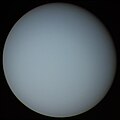File:Uranus.jpg

Dimensioni di questa anteprima: 600 × 600 pixel. Altre risoluzioni: 240 × 240 pixel | 480 × 480 pixel | 750 × 750 pixel.
File originale (750 × 750 pixel, dimensione del file: 37 KB, tipo MIME: image/jpeg)
Cronologia del file
Fare clic su un gruppo data/ora per vedere il file come si presentava nel momento indicato.
| Data/Ora | Miniatura | Dimensioni | Utente | Commento | |
|---|---|---|---|---|---|
| attuale | 07:24, 27 lug 2022 |  | 750 × 750 (37 KB) | CactiStaccingCrane | Reverted to version as of 04:25, 15 May 2015 (UTC) |
| 09:47, 19 nov 2015 |  | 750 × 750 (124 KB) | PlanetUser | modified from File:PIA00032 Uranus in True and False Color.jpg -- edited using Photoshop | |
| 05:25, 15 mag 2015 |  | 750 × 750 (37 KB) | Jcpag2012 | Reverted to version as of 07:18, 13 May 2015 | |
| 08:26, 13 mag 2015 |  | 600 × 609 (16 KB) | Huntster | Reverted to version as of 00:45, 10 November 2004; no need to crop, and combo of paint.net and enlarging it caused significant artefacting. | |
| 08:18, 13 mag 2015 |  | 750 × 750 (37 KB) | Jcpag2012 | crop using paint.net 4.0.5 | |
| 01:45, 10 nov 2004 |  | 600 × 609 (16 KB) | Bobdoe~commonswiki | {{PD-USGov-NASA}} |
Pagine che usano questo file
Le seguenti 20 pagine usano questo file:
- Anelli di Urano
- Atmosfera di Urano
- Cronologia della scoperta di pianeti e satelliti del Sistema solare
- Esplorazione di Urano
- Formazione di Urano
- Legge di Dermott
- Magnetosfera di Urano
- Osservazione di Urano
- Parametri orbitali di Urano
- Pianeta
- Satelliti naturali di Urano
- Sistema di Urano
- Struttura interna di Urano
- Urano nella fantascienza
- Utente:Andrea genovese
- Utente:Henrykus/Portale sistemi planetari
- Utente:Henrykus/Portale sistemi planetari/Galleria
- Template:Urano
- Portale:Sistema solare
- Portale:Sistema solare/Galleria
Utilizzo globale del file
Anche i seguenti wiki usano questo file:
- Usato nelle seguenti pagine di af.wikipedia.org:
- Usato nelle seguenti pagine di ang.wikipedia.org:
- Usato nelle seguenti pagine di ar.wikipedia.org:
- Usato nelle seguenti pagine di ast.wikipedia.org:
- Usato nelle seguenti pagine di as.wikipedia.org:
- Usato nelle seguenti pagine di az.wikipedia.org:
- Usato nelle seguenti pagine di be-tarask.wikipedia.org:
- Usato nelle seguenti pagine di be.wikipedia.org:
- Usato nelle seguenti pagine di bg.wikipedia.org:
- Usato nelle seguenti pagine di bn.wikipedia.org:
- Usato nelle seguenti pagine di bn.wikiquote.org:
- Usato nelle seguenti pagine di br.wikipedia.org:
- Usato nelle seguenti pagine di bs.wikipedia.org:
- Usato nelle seguenti pagine di ca.wikipedia.org:
- Usato nelle seguenti pagine di ckb.wiktionary.org:
- Usato nelle seguenti pagine di cs.wikipedia.org:
- Usato nelle seguenti pagine di cu.wikipedia.org:
- Usato nelle seguenti pagine di da.wikipedia.org:
- Usato nelle seguenti pagine di de.wikipedia.org:
- Usato nelle seguenti pagine di de.wikibooks.org:
- Usato nelle seguenti pagine di de.wiktionary.org:
- Usato nelle seguenti pagine di el.wikipedia.org:
- Usato nelle seguenti pagine di el.wiktionary.org:
- Usato nelle seguenti pagine di en.wikipedia.org:
Visualizza l'utilizzo globale di questo file.


